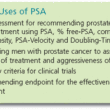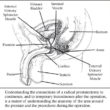The history of PSA screening for prostate cancer
The pre-PSA era
Prostate cancer is the leading cause of non-skin cancer in men (26% of new cancer diagnoses) and the second-leading cause of cancer death (11% of cancer deaths in men). In the period between 1930 and 1985, the prostate cancer mortality rate almost doubled, as fewer men died of cardiovascular disease and more lived long enough to fall victim to prostate cancer. In 1992, 60% of newly diagnosed prostate cancer cases were localized with an 89% 5-year survival rate, and 19% of newly diagnosed cases already metastasized with a 5-year survival rate of only 29%. Thus, underscoring the importance of early cancer detection.

The Dawn of the PSA era
In 1991. Dr. Catalona published a study in the New England Journal of Medicine that was the first to show PSA was useful as a screening test for prostate cancer. This paper ushered in the PSA screening era and led to the launching of large, prospective randomized clinical trials in the U.S. (the Prostate, Lung, Colorectal, and Ovarian Cancer Screening Trial [PLCO]) and in Europe (the European Randomized Screening Study for Prostate Cancer) to formally test the benefits of PSA screening.
The PSA dark ages
In 2008, the U.S. Preventive Service Task Force recommended against screening men older than age 75, erroneously assuming that their life expectancy was too limited to benefit from early prostate cancer detection. In 2009, the first conflicting results from the European and U.S. trials were published in the same issue of the New England Journal of Medicine. The European study supported the use of the PSA, with prostate cancer deaths reduced by 21%. These results were achieved with a 4-year screening interval and use of the PSA tool only, no digital rectal exam. In stark contrast, the PLCO trial reported a 0% decrease in prostate cancer deaths, and stated that approximately 50% of men in the non-screening arm of the trial had actually received at least one PSA test during the trial. In truth, far more men–approximately 90% — in the control group had PSA testing during this trial, but this difference did not come to light for 8 years.

Based on this faulty information, in 2012, the U.S. Preventive Service Task Force Panel (USPSTF), composed of internists, pediatricians, family physicians, obstetricians, gynecologists, and nurses, but no urologists, radiation oncologists, or medical oncologists, issued a Grade “D” recommendation against prostate cancer screening for all men. The Task Force weighed heavily the results of the inaccurately reported negative PLCO trial in their recommendation against screening.
In the years after the Task Force’s recommendation, the rate of PSA screening and prostate cancer interventions declined substantially. The Task Force’s ban on PSA screening remained in place for another 5 years, resulting in a large number of physicians and patients being misinformed that the harms of PSA screening, such as over-diagnosis and overtreatment of harmless prostate cancer, outweighed the benefits of early cancer detection.
By 2014, at the zenith of the PSA screening era, 82% of newly diagnosed cancers were localized for a greater than 99% 5-year survival, while only 4% had metastases at diagnosis – an 80% reduction in the percentage of men presenting with metastases. The national prostate cancer death rate had decreased by 53%. However, for the unfortunate patients who had metastases at the time of diagnosis, the 5-year survival rate remained at only 28% – again documenting the importance of early detection. The National Cancer Institute Surveillance Modeling Network projected that if screening were phased out in 2012, as recommended by the Task Force, the number of cases of distant-stage disease would return to the pre-PSA screening era levels by the year 2025. This prediction was borne out by the trends over the next 5 years (see the article on Abrogation of Survival Disparity Between Black and White Individuals After the USPSTF’s PSA-Based Prostate Cancer Screening Recommendation on page 11).
Unfortunately, the inaccurate reporting of the high percentage of control participants in the U.S. PLCO trial who had undergone PSA screening did not come to light until the data was re-analyzed by a different research group and reported in 2016 in another study published in the New England Journal of Medicine. A separate independent analysis of the PLCO trial data conducted by the U.S. National Cancer Institute statistical modeling group published in 2017, reported that there actually was a 27-32% lower prostate cancer mortality risk in the screening arm of the PLCO trial – even greater than observed in the European trial. Nevertheless, the USPSTF’s guidelines discouraging prostate cancer screening have misinformed a generation of doctors resulting in lasting effects on screening rates and the features of prostate cancers at the time of diagnosis.
The emergence of the importance of active surveillance in the screening debate
In 2018, the Task Force upgraded its screening recommendation, to a Grade of “C” for men ages 55-69 and suggested that men be provided information about the benefits and harms of screening. They stated that the change in recommendation reflected new evidence about the increased use of active surveillance for low-risk prostate cancer, which may reduce the harms from screening. However, they maintained that the benefits of screening of men over 70 do not outweigh the harms and, therefore, they recommended against screening for men age 70 and older – a recommendation that stands today. This recommendation applies to all men who have no signs or symptoms of prostate cancer and includes men at increased risk, such as Black men and men with a family history of prostate cancer.
The aforementioned events signaled the importance of active surveillance for mitigating the potential harms of screening leading to over-diagnosis and overtreatment. A substantial proportion — 30-60% — of patients who appear to have low-risk prostate cancer based on their diagnostic biopsy actually harbor more aggressive disease. Thus, it is important for their surveillance protocol to include serial PSA testing, prostate examinations, and surveillance biopsy procedures to rule out the presence of more aggressive disease. However, after undergoing a few surveillance biopsy procedures, most patients decline any further biopsy procedure. This creates an urgent need for less invasive methods for the risk of aggressive disease for patients on active surveillance. Among the most promising candidates are improved imaging tests, such as MRI and PET scans and biomarkers, especially genetic tests for prostate cancer aggressiveness (See article on Adoption of New Risk Stratification Technologies Within US Hospital Referral Regions and Association with Prostate Cancer Management on page 12.

Genetic Markers of Prostate Cancer Aggressiveness
There are 3 general types of genetic markers for cancer. The first is called “common SNPs” (single nucleotide polymorphisms). Everyone inherits millions of them – half from each parent. So far, more than 400 of them have been discovered that can increase the risk for prostate cancer and possibly its aggressiveness, but each SNP increases risk by only a small amount. Nevertheless, together they can increase the risk up to 4-5 fold – similar to the high risk associated with a BRCA2 gene mutation. Most risk SNPs work across different racial groups, but some are unique to certain races. The assortment of these 400 SNPs that a man has inherited can be incorporated into a polygenic risk score that quantifies his risk attributable to SNPs.
The second type of genetic marker is called rare, highly-penetrant germline variants such as the breast cancer BRCA1 and BRCA2 mutations. Unlike the SNPs, a single pathogenic mutation can dramatically increase the risk for prostate cancer and also for an aggressive form of the disease. Tests for high-risk genetic markers are frequently recommended for people who have a strong family history of certain types of cancer, such as breast, ovarian, prostate, pancreatic, colorectal, uterine, etc.
The third type of genetic test is called a tumor gene expression panel. For these tests, a tumor biopsy sample is sent to the company laboratory where they test a panel of up to a few dozen cancer driver genes to quantify the intensiveness of their expression (i.e., whether they are turned on or turned off). Examples are the Decipher and Oncotype Dx tests. Importantly, the Decipher test has recently been reported to be associated with active surveillance failure.
The Catalona-Witte SPORE project on the germline genetics of active surveillance
Prostate cancer is one of the most heritable cancers, and genetic factors that predispose to aggressive tumors may help distinguish men who are more likely to discontinue active surveillance. To investigate this, Drs. Catalona and his collaborator Dr. John Witte at Stanford University and dozens of other collaborators undertook a multi-institutional genetic study of more than 6000 patients who initially elected active surveillance and were followed over time for the conversion to active treatment.
In the clinical area, they found that early conversion was associated with younger age and a higher Gleason grade group, PSA, tumor stage, and the number of positive biopsy cores. Patients with a high-volume Gleason grade group 1 tumor had a shorter interval to conversion to active treatment than those with low-volume GG1 tumor and behaved similarly to higher-risk patients. Importantly, in an exploratory analysis, they found no association with self-reported race or genetic ancestry, i.e., in contrast to some previous reports, Black men were no more likely to convert than White men.

In the basic science genetics component of the project, they detected 18 SNPs associated with conversion, 15 of which were not previously associated with prostate cancer risk. They also found 2 genes associated with conversion. Moreover, a 269-SNP genetic risk score for prostate cancer was associated with conversion as was a 36-SNP genetic risk score for PSA levels. These results suggest that germline genetics may help inform and individualize the decision of whether or not to adopt active surveillance—or the intensity of monitoring on active surveillance—versus treatment for the initial management of patients with low-risk prostate cancer.
Where we are going
Dr. Catalona’s goal is to replicate their SPORE project results in an independent patient cohort and, therefore, he is working to build a new multi-institutional replication patient cohort of patients to test.
As the Director of the Career Development program of the recently refunded SPORE grant, Dr. Catalona will serve as the mentor for Adam Gordon, PhD on the development and prospective validation of a trans-ancestry polygenic risk score for prostate cancer.
Dr. Catalona along with Dr. Matthew Cooperberg, John Witte, and other colleagues recently submitted a program project grant called “PCASP – the Prostate Cancer Active Surveillance Project,” that is currently under review at the National Cancer Institute”. It involves a multi-institutional research team with expertise in diverse relevant disciplines and includes 7 major research institutions and large community urology practices across the U.S. There are 3 projects: 1) focused on the implementation of active surveillance, 2) the personalization of active surveillance through integration of genetics/genomics, and 3) the cost-effectiveness of the interventions under study. Dr. Catalona is also supporting and participating in Dr. Christopher Haiman’s (the University of Southern California) large NIH-funded study of the genetics of prostate cancer in Black men and is participating in genetic studies of the mechanisms by which BRCA2 mutations lead to cancer at the National Cancer Institute with Dr. Mitchell Machiela and Stephen Chanock.
In summary, Dr. Catalona’s research group has undertaken the first genome-wide association study of conversion from active surveillance to active treatment among men diagnosed with low-risk prostate cancer. This multi-institutional study detected a genetic basis of conversion, suggesting that genetic factors may provide valuable information to stratify men with prostate cancer by their risk of discontinuing active surveillance. Important future work will expand this study to more men placed on active surveillance, increasing the ability to detect genetic variants associated with conversion. This may in turn help address concerns that biopsy sampling may underestimate a tumor’s aggressiveness and provide a more personalized approach to decisions surrounding active surveillance. Finally, by enhancing the ability to more appropriately select patients for active surveillance, it will mitigate the potential harms of PSA screening and thus enhance its appropriate adoption and implementation, further reducing suffering and death from prostate cancer while at the same time minimizing the burdens of treatment.
CA-Cancer J Clin 1992;42:19-38New Engl J Med 1991;324:1 156-61
Eur Urol 2013;6495-114
N Engl J Med. 2009;360:1320-8. [PMID:19297566]
N Engl J Med. 2012;366:981090.[PMID:22417251]
Lancet 2014 [PMID 2510889]
J Natl Cancer Inst. 2012;104:125-32
Urol Clin N Am 2014:41:249-255
NEJM 2009;360:1310-9
Ann Intern Med 2017;166:451-2
From the NCI-sponsored Cancer Intervention and Surveillance Modeling Network (CISNET)
N Engl J Med. 2016;374-18
Ann Intern Med. 2017 Oct 3;167(7):449-455



















